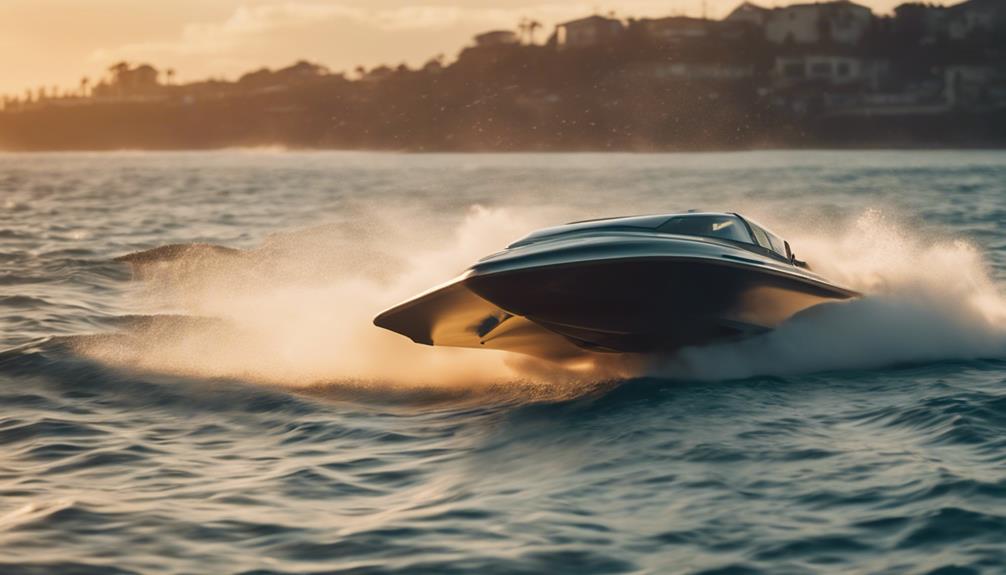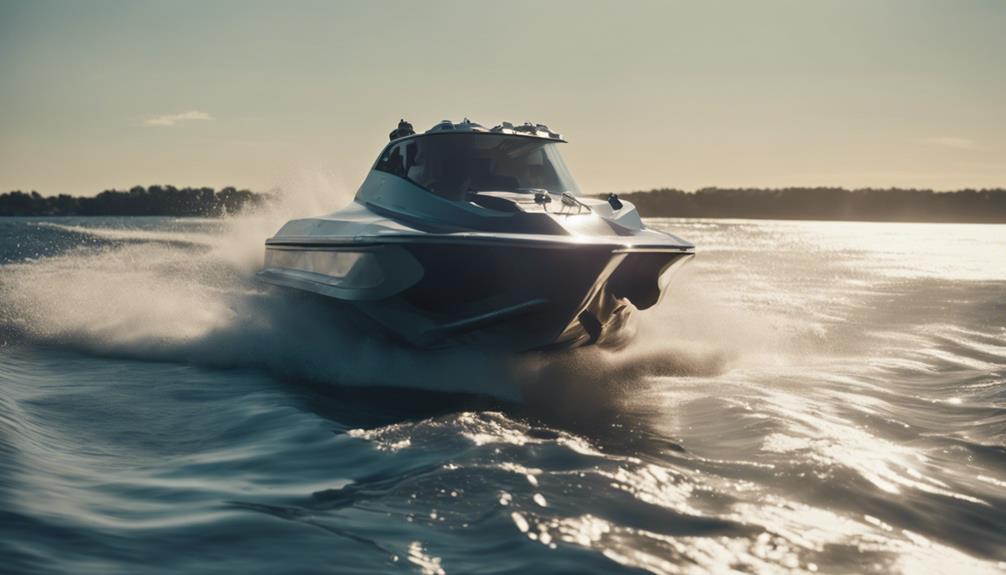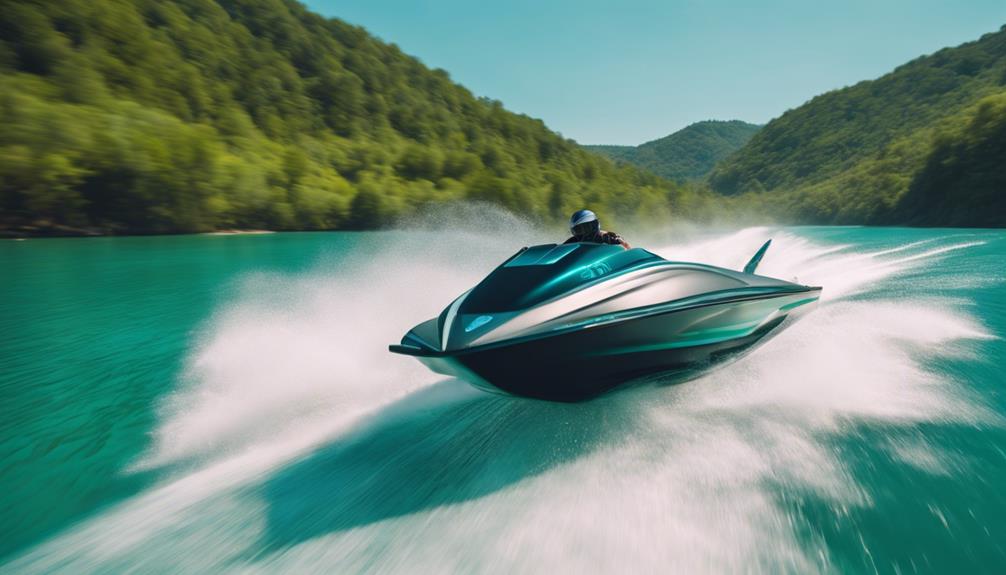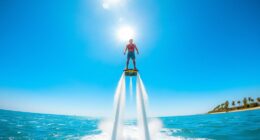Jet boats are fantastic for shallow waters but aren't the best choice for the ocean. Their unique hull design creates handling issues in choppy seas, leading to difficulties with speed and maneuverability. If you're out in rough conditions, you may struggle with control, making propeller-driven boats a more reliable option. Additionally, jet boats can clog with seaweed and debris, which could impact performance. While they require significant maintenance after saltwater use to prevent corrosion, the best way to enjoy jet boating is limited to calm waters. Stick around, and you'll uncover more insights about jet boats and their ocean capabilities!
Key Takeaways
- Jet boats struggle with maneuverability and handling in ocean swells due to their dished hull design, impacting performance in rough waters.
- Regular offshore use of jet boats is not recommended due to potential clogging from debris and seaweed, leading to power loss.
- Skilled throttle management is essential for effective navigation in ocean conditions, making operation challenging for less experienced users.
- Jet boats are ideal for shallow waters and water sports but may not provide the control and comfort needed for long offshore trips.
Jet Boat Overview
Jet boats are purpose-built for traversing shallow waters, making them perfect for rocky environments and thrilling water sports.
With their unique jet drive system, these boats suck water from beneath and expel it out the back, allowing for smooth navigation in areas where traditional propeller boats struggle. This design not only enhances safety by reducing the risk of hitting submerged obstacles, but it also provides a quick shift to plane, ideal for activities like water skiing.
Yamaha jet boats, such as the SX192 and SX230HO, are popular choices for leisure enthusiasts who want to enjoy their time on the water without worrying about depth.
These models showcase the efficiency of inboard jet boats, which outperform outboard jets in shallow water conditions.
While they excel in calm environments, it's important to remember that jet boats may not handle rough water well due to their dished hull design and sensitivity to debris and weeds.
As a result, if you're planning to venture into varying water conditions, be mindful of the limitations of these remarkable vessels.
Performance in Ocean Conditions

While jet boats excel in calm waters, their performance in ocean conditions can present considerable challenges due to their design. The dished hull of a jet boat can lead to poor handling and power loss when facing swells. Many users find that while jet boats operate well in peaceful ocean settings, they struggle notably in strong winds and choppy waves.
When you compare their performance to traditional propeller-driven boats, you'll notice that jet boats often have a harder time maintaining speed and maneuverability in rough waters. User experiences highlight that steering offshore requires skilled throttle management, as improper handling can lead to a frustrating experience.
Moreover, jet boats aren't recommended for regular offshore use because they tend to clog with debris and seaweed. This can result in cavitation, which further contributes to power loss.
Maintenance for Saltwater Use
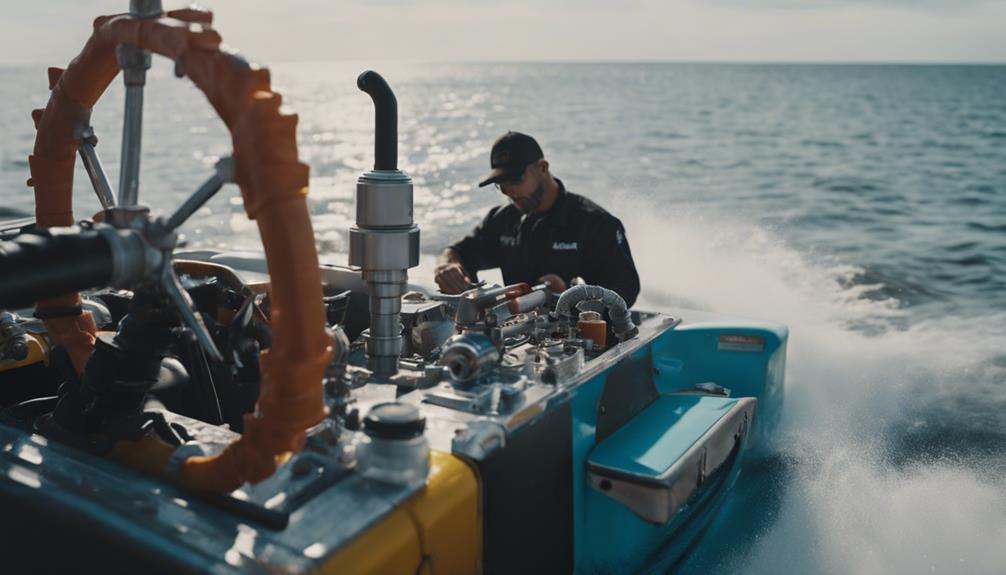
When you take your jet boat out in saltwater, regular rinsing is essential to protect it from corrosion.
You'll want to implement effective corrosion prevention techniques and give extra attention to engine and hull care to keep everything running smoothly.
Staying on top of maintenance will guarantee your boat remains in top shape for all your ocean adventures.
Regular Rinsing Importance
Regularly rinsing your jet boat after saltwater use is essential to prevent corrosion and maintain its performance. Saltwater can wreak havoc on various components, particularly aluminum parts, which are highly susceptible to damage. By rinsing your boat thoroughly, you remove salt, sand, and debris that can lead to corrosion over time.
Don't forget to give special attention to the jet drive and intake system. A thorough rinse will clear out any seaweed or sand that might clog these critical areas, ensuring your boat operates smoothly. The more you expose your jet boat to saltwater, the more frequent your maintenance routine should be. Regular rinsing becomes a crucial part of your upkeep, reducing the risk of mechanical issues.
Additionally, using clean-out plugs after each outing can help remove debris from the intake, enhancing your boat's reliability. By incorporating regular rinsing into your maintenance routine, you're not just prolonging the life of your jet boat; you're also ensuring it performs at its best.
Corrosion Prevention Techniques
To effectively prevent corrosion on your jet boat in saltwater, it's crucial to employ a combination of maintenance techniques tailored specifically for marine environments.
Start by rinsing your boat with freshwater after each use to eliminate salt and debris that can accelerate corrosion, especially in aluminum components and the jet system. This simple step goes a long way in maintaining the integrity of your boat.
Next, increase your maintenance frequency by lubricating moving parts biannually. This helps counteract wear caused by exposure to harsh saltwater conditions. You should also schedule routine inspections of the impeller and reverse gate to catch any signs of corrosion or mechanical issues early.
Don't forget to utilize clean-out plugs to remove floating debris from the intake. This reduces the risk of clogging and potential damage to your jet system.
Additionally, regularly check the hull for scratches or damage, addressing any issues promptly to guarantee your jet boat remains reliable and long-lasting in saltwater environments.
Engine and Hull Care
Caring for your jet boat's engine and hull is essential for guaranteeing peak performance and longevity in saltwater conditions. Since saltwater can be harsh, you'll need to increase your maintenance frequency. Rinse your boat thoroughly after each use to prevent corrosion and debris accumulation in the intake. Pay special attention to aluminum components, as they're particularly vulnerable.
Every six months, lubricate moving parts and check the impeller and reverse gate functionality to keep everything running smoothly. Don't forget about the clean-out plugs; they're fundamental for removing debris that can affect performance. Regularly inspect these plugs to verify they're functioning correctly.
Additionally, maintaining your hull is crucial. Regular cleaning helps prevent marine growth, which can negatively impact your jet drive system. Set a schedule to scrub the hull and check for any signs of damage or wear.
Advantages of Jet Boats

Jet boats offer numerous advantages, such as their ability to quickly shift to plane and navigate shallow waters, making them ideal for water sports enthusiasts and adventurous outings.
One of the standout advantages of jet boats is their shallow draft, typically between 12 to 17 inches, which allows you to explore areas where traditional propeller-driven boats can't go. This means you can access hidden coves and pristine beaches that are often unreachable.
Additionally, the absence of exposed propellers enhances safety for swimmers and skiers, greatly reducing the risk of injuries. When you're out on the water, you'll appreciate how modern jet propulsion systems provide superior maneuverability and instant throttle response, making it easy to handle the boat during low-speed maneuvering.
Moreover, many jet boats feature open deck layouts that enhance usability and comfort, accommodating larger groups and allowing for more activities on board.
Whether you're cruising, fishing, or engaging in thrilling water sports, the advantages of jet boats make them a popular choice for those seeking excitement and versatility on the water.
Disadvantages of Jet Boats

When you're out on the ocean, jet boats can present several challenges.
You might find their low-speed maneuverability lacking, making tight navigation tricky in choppy waters.
Plus, their performance often suffers in rough conditions, raising concerns about maintenance and reliability.
Low-Speed Maneuverability Challenges
Low-speed maneuverability can be a significant challenge for operators of jet boats, often hindering their ability to navigate tight spaces effectively. Jet boats rely on smaller steering nozzles, which can create steering challenges when you're trying to move slowly. Unlike traditional vessels with propeller reversal systems, jet boats use a reverse gate to redirect water flow, complicating low-speed steering even further.
You might find that handling your jet boat in confined areas or around obstacles requires more skill and experience than you initially anticipated. Many operators report that it takes time to master the unique handling characteristics of jet boats, especially if you're used to propeller-driven models.
When conditions like strong winds or rough seas come into play, you may experience diminished control, making it even harder to maintain direction. These factors can turn what should be a simple maneuver into a frustrating challenge, emphasizing the importance of practice.
Ultimately, while jet boats offer thrilling speed and performance, their low-speed maneuverability can be a significant drawback you'll need to take into account when operating in tight or congested environments.
Rough Water Limitations
Many operators find that jet boats struggle considerably in rough water conditions due to their unique hull design, which can lead to a loss of power and control. The dished hull often makes it difficult to navigate through ocean swells and chop, resulting in a diminished performance that can catch you off guard.
You may notice that your jet boat's maneuverability is compromised in strong winds and turbulent seas, making it less reliable for offshore adventures. As you encounter rough water, you'll likely need to manage the throttle with care, requiring a level of skill and experience to maintain control.
Many jet boat operators report discomfort and difficulty when handling their vessels in these conditions, emphasizing the importance of calm water for peak operation. Additionally, jet boats can clog with seaweed and debris, further complicating performance issues and increasing the risk of cavitation in turbulent environments.
If you're planning to venture into rough waters, it's vital to weigh these limitations of jet boats carefully before setting out.
Maintenance and Reliability Concerns
Jet boats demand more upkeep in saltwater conditions, primarily due to the heightened risk of corrosion affecting their aluminum components. This means you'll need to regularly rinse your boat and lubricate moving parts at least biannually. If you don't stay on top of maintenance, you could face significant reliability issues.
Another concern is the intake system, which can easily clog with debris and seaweed. This can lead to cavitation and power loss, making your jet boat less reliable, especially in rough ocean conditions.
Choosing the right combination of engine and propulsion systems is also essential; a mismatch can lead to further maintenance headaches and decreased performance.
You should also note that jet boats tend to be less fuel-efficient than traditional boats, consuming about 30% more fuel. This could be a significant drawback for longer trips.
User Experiences and Feedback

User feedback on jet boats in the ocean reveals a mix of satisfaction and frustration, particularly influenced by weather conditions. Many users find their performance acceptable on calm days, appreciating their speed and maneuverability. However, when facing rough waters, frustrations mount. You might struggle to maintain control and power during swells, leading to a less enjoyable experience.
Here's a summary of user experiences:
| Condition | User Satisfaction | Common Issues |
|---|---|---|
| Calm Waters | High | None reported |
| Moderate Seas | Moderate | Limited steering control |
| Rough Waters | Low | Difficulty maintaining power |
Transitioning to propeller-driven systems often boosts steering control and fuel efficiency, especially for regular ocean adventurers. Careful planning is essential when operating jet boats in saltwater, as debris can clog systems, further impacting maneuverability in challenging conditions. While jet boats can shine on good days, many users suggest opting for boats designed specifically for ocean use if you plan to venture offshore frequently.
Considerations for Ocean Use

When venturing into the ocean, it's vital to understand the limitations of jet boats, especially in rough conditions. Unlike prop boats, jet boats often struggle to maintain power and control in choppy seas, making them less suitable for regular offshore activities.
Here are some significant considerations for using jet boats in the ocean:
- Jet boats have a dished hull design that can lead to diminished performance on swells.
- They're prone to clogging from seaweed and debris, impacting power and efficiency.
- Skilled throttle management is important for maneuvering ocean swells safely.
- Jet boats excel in shallow waters but not in rough conditions.
While jet boats can be enjoyable for short, calm outings, their capabilities diminish in turbulent waters.
If you plan to traverse rough seas, consider the challenges and weigh your options carefully.
Opting for a prop boat may provide better control, fuel efficiency, and comfort, especially during extended trips.
Always prioritize safety and choose the right vessel for the conditions you'll face.
Frequently Asked Questions
Are Jet Boats OK in the Ocean?
Jet boats can handle the ocean, but they're not ideal for rough waters. You'll struggle with power and maneuverability in swells, so consider a boat designed for ocean use if you plan to venture offshore.
What Are the Downsides of Jet Boats?
Jet boats have several downsides. You'll find they struggle with low-speed control, can clog easily from debris, and often lack seaworthiness, resulting in poor performance on choppy waters and requiring frequent maintenance in saltwater.
What Are Jet Boats Good For?
Jet boats are like sleek cheetahs on water, excelling in shallow areas. You'll love their quick acceleration, safe design, and spacious layouts for social outings, making them perfect for thrilling adventures and relaxing days on the water.
Are Jet Boats Good in Rough Water?
Jet boats aren't great in rough water. You'll struggle with stability and control, especially in choppy seas. They can clog easily, and managing throttle becomes tricky, affecting your overall performance and ride quality.
Can Jet Boats Have a Negative Impact on the Ocean Environment?
Jet boats have been known to have a significant environmental impact on the ocean. According to jet boats environmental impact facts, the fast speed and high-power engines can disturb marine life, cause noise pollution, and contribute to water and air pollution. It’s important to consider these factors when enjoying jet boating activities.
Conclusion
In the end, jet boats can be a thrilling ride across ocean waves, carving through the water like a sleek dolphin.
However, remember to weigh the pros and cons before you set sail. With the right maintenance and care, you can enjoy the sun-kissed adventures that await.
Just picture yourself gliding through the surf, the salty breeze in your hair, but stay mindful of the challenges that come with ocean use.
Happy boating!

